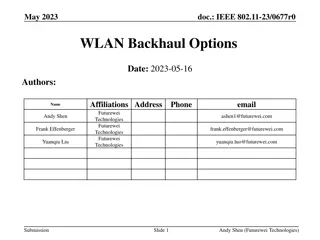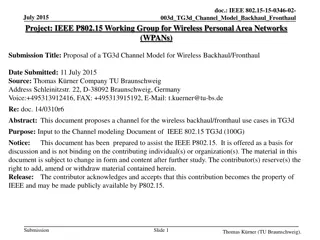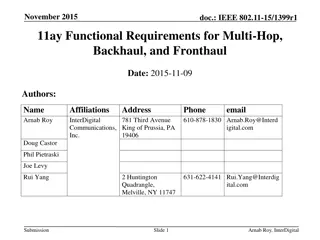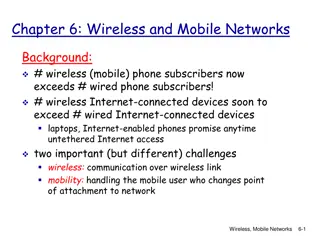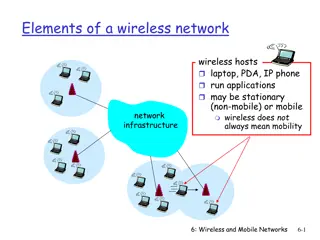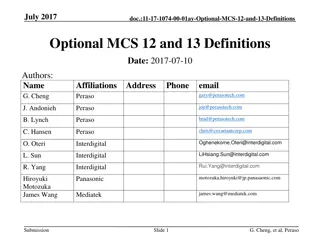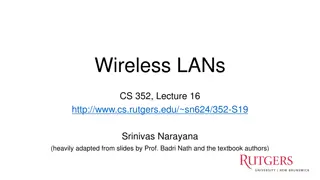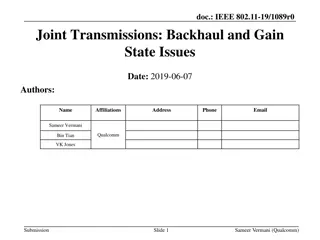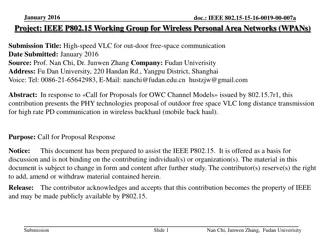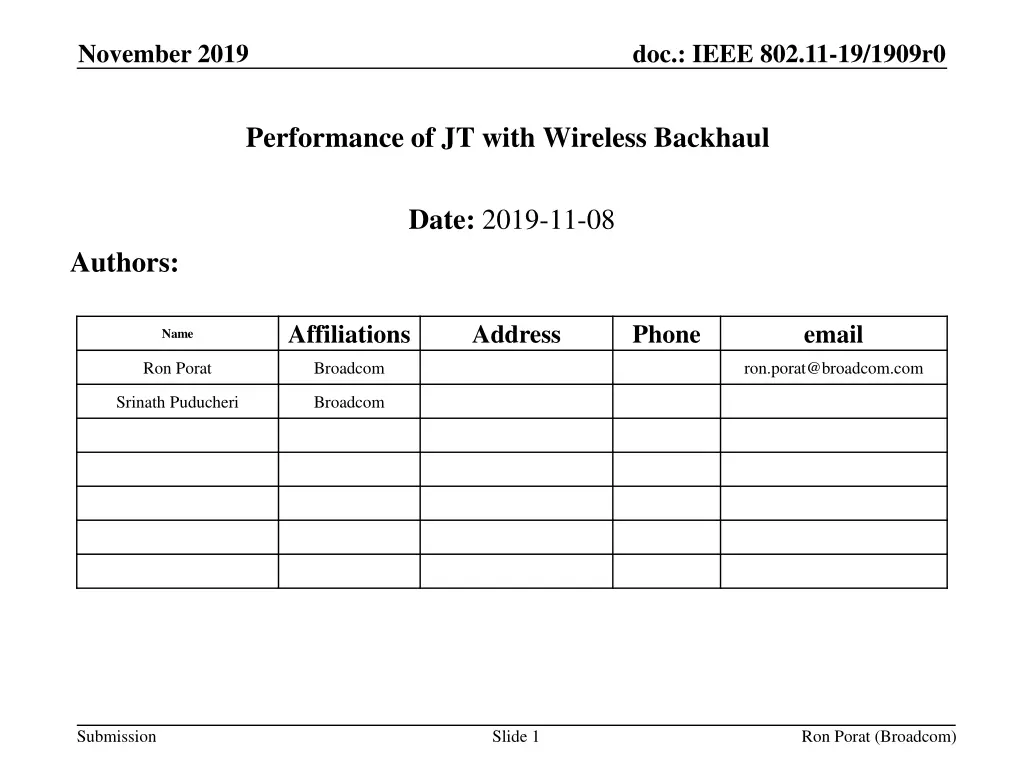
Performance Analysis of IEEE 802.11 JT with Wireless Backhaul
Explore the system-level performance of Joint Transmission (JT) with wireless backhaul compared to a baseline mesh deployment in enterprise settings. The study considers backhaul overhead, channel optimization, and throughput metrics for different access point configurations. Gain insights into the efficiency of backhaul bandwidth utilization and overall network performance.
Download Presentation

Please find below an Image/Link to download the presentation.
The content on the website is provided AS IS for your information and personal use only. It may not be sold, licensed, or shared on other websites without obtaining consent from the author. If you encounter any issues during the download, it is possible that the publisher has removed the file from their server.
You are allowed to download the files provided on this website for personal or commercial use, subject to the condition that they are used lawfully. All files are the property of their respective owners.
The content on the website is provided AS IS for your information and personal use only. It may not be sold, licensed, or shared on other websites without obtaining consent from the author.
E N D
Presentation Transcript
November 2019 doc.: IEEE 802.11-19/1909r0 Performance of JT with Wireless Backhaul Date: 2019-11-08 Authors: Affiliations Address Phone email Name Ron Porat Broadcom ron.porat@broadcom.com Srinath Puducheri Broadcom Submission Slide 1 Ron Porat (Broadcom)
November 2019 doc.: IEEE 802.11-19/1909r0 Abstract In our previous contribution ([1]), we looked at JT performance on the fronthaul, which provides a true indication of JT performance gains when the backhaul is wired [4] (e.g, enterprise deployments). In this contribution we provide results on system-level performance of JT assuming wireless backhaul ([2], [3]) and compare it with a baseline mesh deployment. Note that both JT and mesh use backhaul with differences explained in the following slides Submission Slide 2 Ron Porat (Broadcom)
November 2019 doc.: IEEE 802.11-19/1909r0 System model (1) We assume a wireless mesh model comprising a master AP and one or more slave APs. Master AP communicates with slave APs over wireless backhaul. Master and slave APs communicate with STAs over wireless fronthaul. Backhaul operation: Backhaul assumed on different channel from fronthaul, as typical of current mesh deployments. Mesh: Master AP forwards each STA s data to corresponding slave AP. JT: Master AP broadcasts all STAs data to all slave APs. JT incurs higher backhaul-overhead than mesh: 2x for 2AP, 1.5x for 3AP and 1.33x for 4AP, assuming symmetric distribution of STAs. Backhaul BW: Mesh: same BW for fronthaul and backhaul JT: backhaul BW either same or 2x that of fronthaul Submission Slide 3 Ron Porat (Broadcom)
November 2019 doc.: IEEE 802.11-19/1909r0 System model (2) Backhaul MCS and Nss assumed to be the same for both JT and mesh. Fronthaul operation as in [1]: Mesh: Master and slave APs share the medium in a TDMA fashion, with each AP transmitting to only its STAs. JT: Master and slave APs jointly transmit to all STAs Simulation results assume 80MHz for fronthaul and 80/160MHz for JT backhaul. Gains expected to be same with BW scaled up proportionally for both fronthaul and backhaul. Overhead due to sounding and AP-AP coordination is ignored. Submission Slide 4 Ron Porat (Broadcom)
November 2019 doc.: IEEE 802.11-19/1909r0 Performance Metrics System throughput for JT = min(Backhaul PHY rate, Fronthaul PHY rate) System throughput for mesh = Average Fronthaul PHY rate Assuming backhaul is not the bottleneck. For JT and mesh: System throughput Fronthaul BW + Backhaul BW BW-normalized throughput = Metrics: 1. Throughput gain = System throughput for JT System throughput for mesh 2. BW-normalized gain = BW normalized throughput for JT BW normalized throughput for mesh Submission Slide 5 Ron Porat (Broadcom)
November 2019 doc.: IEEE 802.11-19/1909r0 Fronthaul simulation model (1) Channel: 11nD, 80MHz, -30dBc channel aging Mesh: TDMA across different BSS, each with AP =4 ant., STA = 2 ant., Nss = 2. JT: Per-AP tx power = 1.0; 2AP: AP = [4 4] ant., STA = [2 2] ant., Nss = [2 2] Total tx power boosted by 3dB 3AP: AP = [4 4 4] ant., STA = [2 2 2] ant., Nss = [2 2 2] Total tx power boosted by 5dB 4AP: AP = [4 4 4 4] ant., STA = [2 2 2 2] ant., Nss = [2 2 2 2] Total tx power boosted by 6dB Cross-BSS path-loss: each STA sees 0dB from own-BSS AP and X=10 dB from remaining APs AP-STA SNR in all plots (x-axis) refers to own-BSS SNR Submission Slide 6 Ron Porat (Broadcom)
November 2019 doc.: IEEE 802.11-19/1909r0 Fronthaul simulation model (2) JT impairments: (see [1] for details) Relative phase offset ? = 4 degrees of slave AP w.r.t. master during joint data TX. Relative timing offset ? = 0.5ns of slave AP w.r.t master during joint data TX. TX gain offset = 0.5dB of slave APs relative to master during joint data TX. Magnitude of phase, timing and TX gain offsets same across slave APs. Signs are chosen independently per slave AP, per parameter. STA channel drift during joint TX data frame, with common-phase tracking on pilots. Channel estimation error during joint-sounding (no smoothing) TxEVM on master and slave APs corresponding to 256-QAM Mesh impairments: Channel estimation error during sounding (no smoothing) TxEVM on master and slave APs corresponding to 256-QAM Submission Slide 7 Ron Porat (Broadcom)
November 2019 doc.: IEEE 802.11-19/1909r0 Simulation results: infinite backhaul For reference, assuming backhaul has infinite rate or wired Config Throughput gain @ different AP-STA SNR 20dB 25dB 30dB AP = 4,4,4,4 STA = 2,2,2,2 3.19 3.47 3.12 AP = 4,4,4 STA = 2,2,2 2.51 2.72 2.39 AP = 4,4 STA = 2,2 1.69 1.87 1.65 Submission Slide 8 Ron Porat (Broadcom)
November 2019 doc.: IEEE 802.11-19/1909r0 Simulation results: finite backhaul (1) JT backhaul BW = 80MHz BW-normalized gain = throughput gain, since JT and mesh both use same fronthaul and backhaul BW = 80MHz Some cases are bottlenecked by backhaul (vs infinite backhaul) Config Backhaul MCS, Nss Throughput gain @ different AP-STA SNR 20dB 25dB 30dB AP = 4,4,4,4 STA = 2,2,2,2 9, 4 3.19 2.70 2.13 9, 3 2.68 2.03 1.60 AP = 4,4,4 STA = 2,2,2 9, 4 2.51 2.70 2.13 9, 3 2.51 2.03 1.60 AP = 4,4 STA = 2,2 9, 4 1.69 1.87 1.65 9, 3 1.69 1.87 1.60 Submission Slide 9 Ron Porat (Broadcom)
November 2019 doc.: IEEE 802.11-19/1909r0 Simulation results: finite backhaul (2) JT backhaul BW = 160MHz, Throughput Gain None of the cases considered here are bottlenecked by backhaul. Config Backhaul MCS, Nss Throughput gain @ different AP-STA SNR Gain vs 80MHz backhaul 20dB 25dB 30dB AP = 4,4,4,4 STA = 2,2,2,2 9, 4 3.19 3.47 3.12 Mid-high SNR 9, 3 3.19 3.47 3.12 All SNR AP = 4,4,4 STA = 2,2,2 9, 4 2.51 2.72 2.39 High SNR 9, 3 2.51 2.72 2.39 Mid-high SNR AP = 4,4 STA = 2,2 9, 4 1.69 1.87 1.65 No 9, 3 1.69 1.87 1.65 No Submission Slide 10 Ron Porat (Broadcom)
November 2019 doc.: IEEE 802.11-19/1909r0 Simulation results: finite backhaul (3) JT backhaul BW = 160MHz, BW-normalized Gain BW-normalized gain is lower than throughput gain since we assume mesh backhaul is still 80MHz. However, for practical mesh deployments, this may be a less relevant metric than throughput gain. Config Backhaul MCS, Nss BW-normalized gain @ different AP-STA SNR 20dB 25dB 30dB AP = 4,4,4,4 STA = 2,2,2,2 9, 4 2.13 2.31 2.08 9, 3 2.13 2.31 2.08 AP = 4,4,4 STA = 2,2,2 9, 4 1.67 1.81 1.59 9, 3 1.67 1.81 1.59 AP = 4,4 STA = 2,2 9, 4 1.12 1.24 1.10 9, 3 1.12 1.24 1.10 Submission Slide 11 Ron Porat (Broadcom)
November 2019 doc.: IEEE 802.11-19/1909r0 JT gains vs backhaul spectral efficiency Looked at one example case: 3AP case, 25dB fronthaul AP-STA SNR Backhaul spectral efficiency = number of data bits per sub-carrier = ????? ??? {MCS, Nss} Backhaul spectral efficiency {9,4} 26.67 {8,4} 24 {9,3}, {7,4} 20 {8,3}, {6,4} 18 {5,4} 16 {7,3} 15 {6,3} 13.5 {5,3}, {4,4} 12 Submission Slide 12 Ron Porat (Broadcom)
November 2019 doc.: IEEE 802.11-19/1909r0 Conclusions We have shown that, in various deployment configurations and different figures of merit, JT with wireless backhaul does have gains compared to typical mesh deployments. This is true even in cases where JT is backhaul-limited since the backhaul rate is still much higher than fronthaul mesh rates. Choice of JT backhaul BW depends on fronthaul configuration and SNR. 160MHz backhaul is not always necessary. Submission Slide 13 Ron Porat (Broadcom)
November 2019 doc.: IEEE 802.11-19/1909r0 References 1. JT performance with Multiple Impairments, IEEE 802.11-19/1597 2. Joint Transmissions: Backhaul and Gain State Issues, IEEE 802.11-19/1089 3. Multi-AP backhaul analysis, IEEE 802.11-19/1588 4. Consideration on Joint Transmission, IEEE 802.11-19/1595 Submission Slide 14 Ron Porat (Broadcom)

